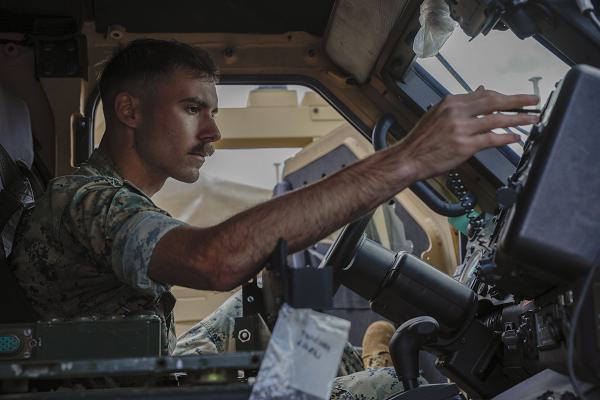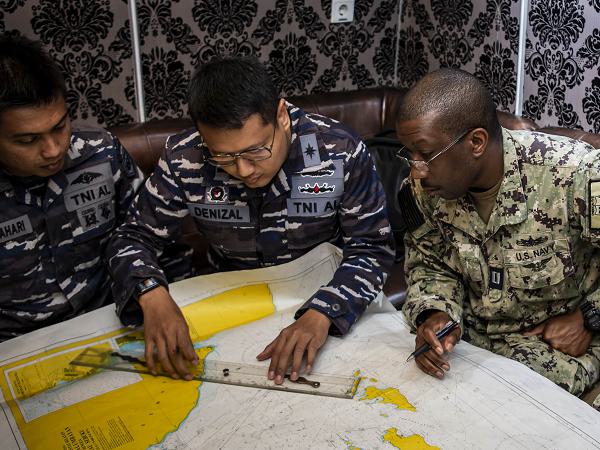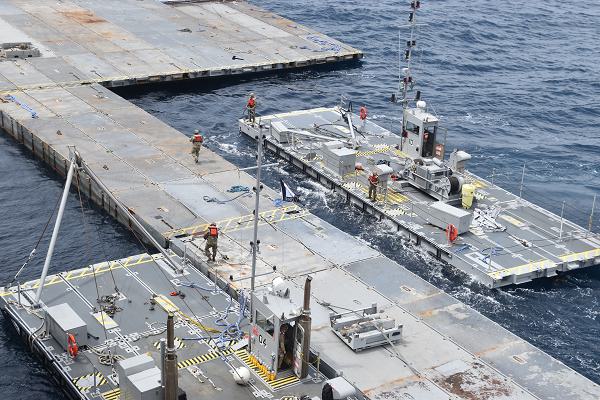- Details
- Hits: 1011

Camp Lejeune, North Carolina. (June 1, 2024): There is an old saying “Drivers may not be the pride of the ride, but without them, the pride don’t ride”. In this photo by Corporal Megan Ozaki, Marine Corporal Gage Barbieri with Headquarters Battalion, 2d Marine Division works on a Joint Light Tactical Vehicle. Officially called Motor Transport Operators, these dedicated professionals are responsible for maintaining and operating both commercial and tactical vehicles.
They operate wheeled vehicles of all kinds to transport cargo and troops over rough terrain in support of combat operations. They make sure all vehicles are inspected and maintained in top condition and ready to go into combat. Operators also oversee repair and maintenance of transport equipment including fuel and water tankers that are essential to support units in the field. They are also experts on the proper loading and unloading of cargo and convoy defense techniques. They also prepare vehicles for movement via air, rail, or sea.
To become a Motor Transport Operator, candidates must pass 10 weeks of Basic Combat Training followed by six weeks of Advanced Individual Training at Fort Leonard Wood, Missouri. The training is a mix of classroom work and simulators plus over two hundred hours spent in actual vehicles in field training environments. Training subjects include loading/unloading operations, vehicle-mounted navigation, and Global Positioning Satellite (GPS) systems, radio communications, convoy security and defense, and the safe transport of Hazardous Materials.
While not the flashiest of jobs in the military, Motor Transport Operators are the backbone of all logistics and combat missions.
- Details
- Hits: 976

Saudi Arabia. (May 28, 2024): To achieve air superiority over the enemy, America flies the most sophisticated aircraft in the world. However, these fifth-generation fighters are useless without somewhere to land and take off. In the photo above, an Air Force pavement and equipment technician assigned to the 378th Expeditionary Civil Engineer Squadron cuts concrete to repair the flightline. The success of any air campaign rests on the skill and technical expertise of these specialists to keep runways operating in some of the most austere environments in the world.
Pavement and equipment technicians construct and maintain asphalt runways, aircraft parking spaces, and roadways. Their job involves everything from construction duties to detonating explosives as they build runways and create the needed facilities. They operate and maintain heavy construction equipment such as loaders, graders, bulldozers, backhoes, and dump trucks. They also transport heavy equipment in tractor-trailer combinations quickly and safely to where they are needed. Once on site, these technicians ensure that all safety and environmental regulations are followed in the handling and storing of construction materials. Perhaps the most dangerous part of their job is designing demolition projects and placing and detonating explosives.
To become a pavement and equipment technician, candidates must be at least seventeen and possess a high school diploma or equivalent. After Basic, students attend sixty-nine days of advanced training at Fort Leonard Wood, Missouri and are likely to be deployed overseas in support of air operations.
America’s sophisticated aircraft can land virtually anywhere in the world thanks to these highly trained runway construction crews.
- Details
- Hits: 2844

Undisclosed Location. (May 31, 2024): In this photo by Sgt. Vincent Levelev, Charlie Company of the 82nd Combat Aviation Brigade, 82nd Airborne Division prepares to take off for a practice “Dust Off” medical evacuation. "DUSTOFF" is the callsign specific to U.S. Army Air Ambulance units made famous during the Vietnam War. During the conflict, helicopter air ambulance pilots along with medics and crew risked their lives to evacuate more than 900,000 U.S., Vietnamese, and even enemy Viet Cong between 1962 and 1973.
Medical air evacuation using helicopters was first attempted during the Korean War and was a new and untested concept when the 57th Medical Detachment arrived in Vietnam in 1962. Beginning with only five helicopters and nine pilots, its leader, Major Charles L. Kelly, set the example by flying a punishing schedule of missions in all weather and hazard conditions. He pioneered new techniques for night evacuations, and he inspired his fellow pilots by swooping his unarmed helicopter into hotly contested landing zones to pluck the wounded from certain death.
- Details
- Hits: 933

Bandar Lampung, Indonesia. (May 15, 2024): In this photo by MC2 James Finney, U.S. and Indonesian Navy leaders review a chart during a planning briefing aboard the Indonesian Navy fast attack craft Kri Kerambit-627 during Combined Afloat Readiness and Training (CARAT).
CARAT Indonesia is a bilateral exercise that is part of a “comprehensive strategic partnership” between Indonesia and the United States designed to promote regional security cooperation. Joined by the navies of Japan and Australia, the exercise enhances the ability of partners to operate together during emergencies throughout the Indo-Pacific.
In its 30th year, the CARAT series allows partners to share information and coordinate efforts at maritime security including fighting terrorism, stopping smuggling, and combatting piracy. Indonesia is the most populous country in Southeast Asia and has the largest Muslim population in the world. Sitting astride the equator, Indonesia is situated on an archipelago that contains 17,508 islands (6,000 inhabited) strategically located along major sea lanes connecting the Indian to the Pacific Oceans. Indonesia measures 3,200 miles from east to west and claims an exclusive economic zone of 200 nautical miles.
This enormous territory is patrolled by the Indonesian Navy which is the second strongest navy in Asia and the fourth largest in the world. It has sixty-five thousand active-duty Sailors, 213 ships of all types including seventy-two patrol craft and thirty-two logistics and support vessels. Due to frequent disasters, the Indonesian Navy must also be prepared to respond to humanitarian crises, like the 2004 Indian Ocean Tsunami, that killed over a million people not counting thousands missing or homeless.
- Details
- Hits: 1162

Annapolis, Maryland. (May 19, 2024): It is a greasy tradition, a slippery custom enthusiastically endured by every class of freshman, or plebes, at the U.S. Naval Academy. In this photo by Stacy Godfrey, U.S. Naval Academy freshmen climb the Herndon Monument, a tradition symbolizing the successful completion of the midshipmen’s freshman year. The class of 2027 completed the climb in 2 hours, 19 minutes and 11 seconds.
The Herndon Monument is dedicated to the memory of Captain William Lewis Herndon who died during the sinking of his ship the SS Central America in 1857. Captain Herndon is credited with saving 152 women and children during a three-day hurricane off the coast of North Carolina. He safely transported them to another vessel while remaining aboard his ship along with four hundred passengers and crew who drowned as the vessel sank off Cape Hatteras. It was the largest loss of life in a commercial ship disaster in U.S. history.
- Details
- Hits: 962

Mediterranean Sea. (May 19, 2024): The Army’s “Navy” has finished constructing a floating pier off the coast of Gaza City and relief supplies are on the way to Palestinian citizens. In the photo above, U.S. Army Soldiers from the 7th Transportation Brigade (Expeditionary) and Sailors attached to the Bob Hope-class large, medium speed roll-on, roll-off ship MV Roy P. Benavidez finish completing assembly of this enormous floating pier.
According to the US Agency for International Development (USAID) approximately 695 metric tons of humanitarian aid has been transported to Gaza by way of the US-built pier over the six days since it began operation.
Built at a cost of approximately $300 million, the pier has offloaded some 500 metric tons of food, water, and medicine for distribution by local humanitarian agencies. As of this week, two thirds of that aid have been delivered or is in the process of reaching those in need. Although aid groups have encountered many obstacles, the U.S. effort has significantly increased the flow of much needed supplies.
The 7th Transportation Brigade (Expeditionary) is known as "the most deployed unit in the U.S. Army” due to its continuous missions to provide logistical support to all branches of the service. Unofficially the Army’s Navy, the brigade is a component of the XVIII Airborne Corps and has a strength of four thousand Soldiers who operate fifty-nine vessels and over a thousand ground vehicles (mostly material handling equipment).


